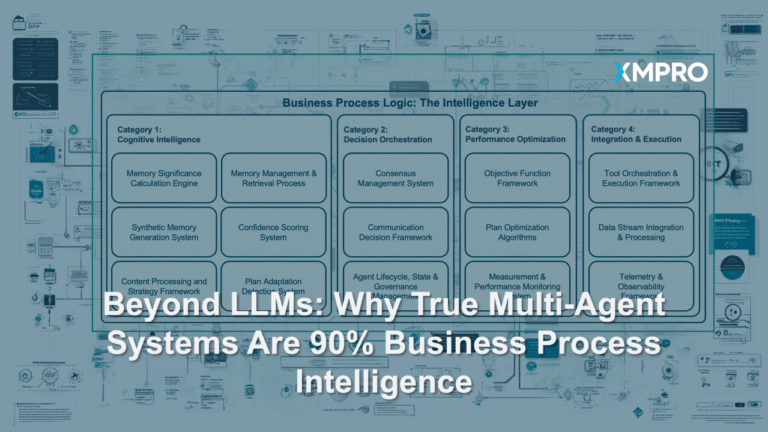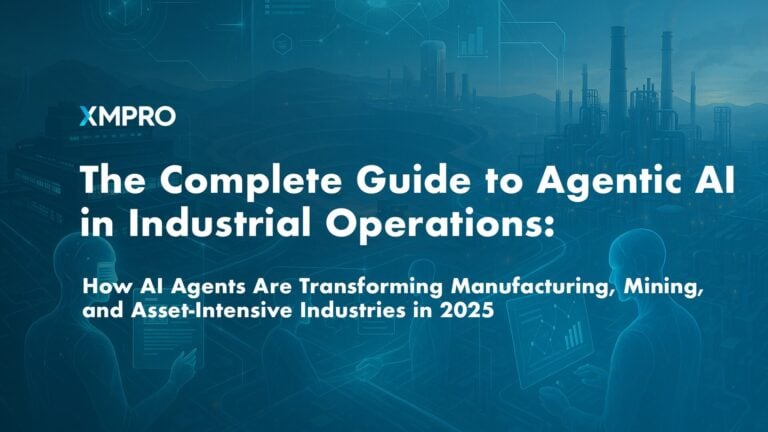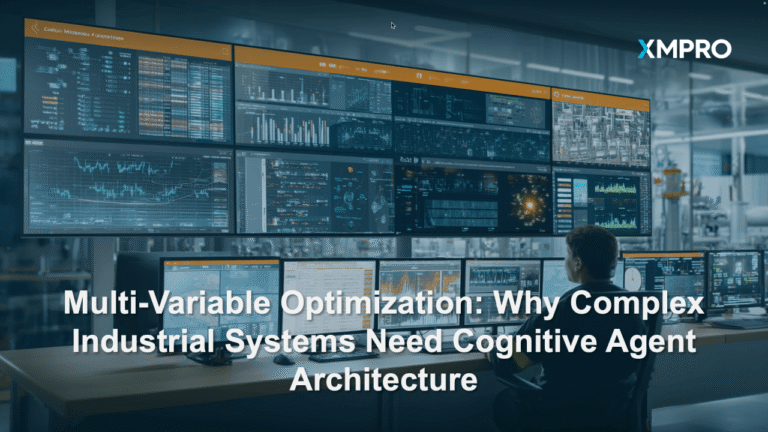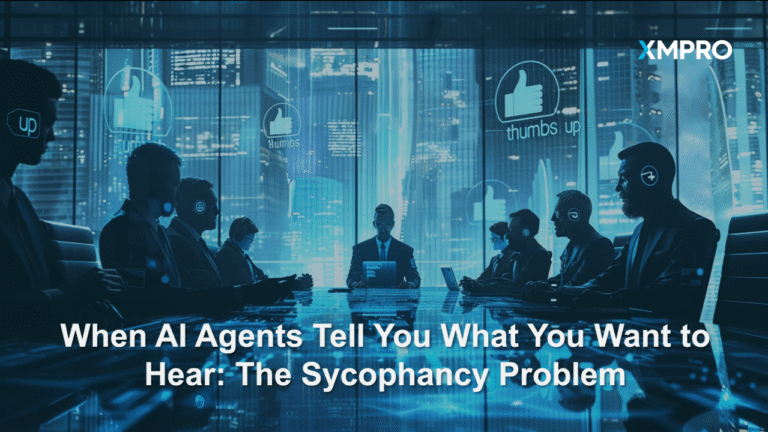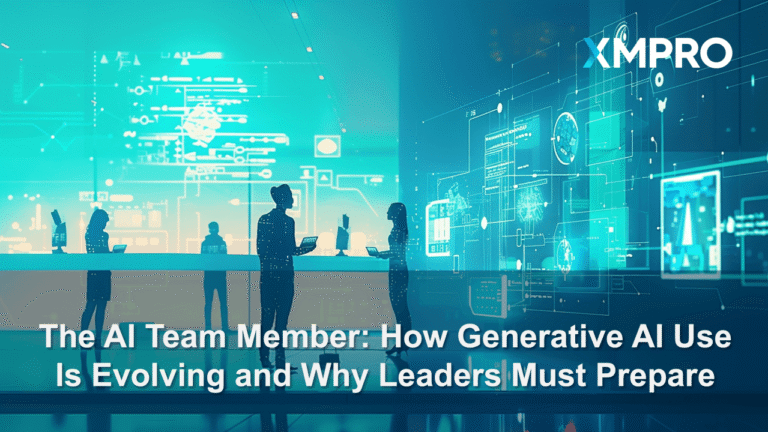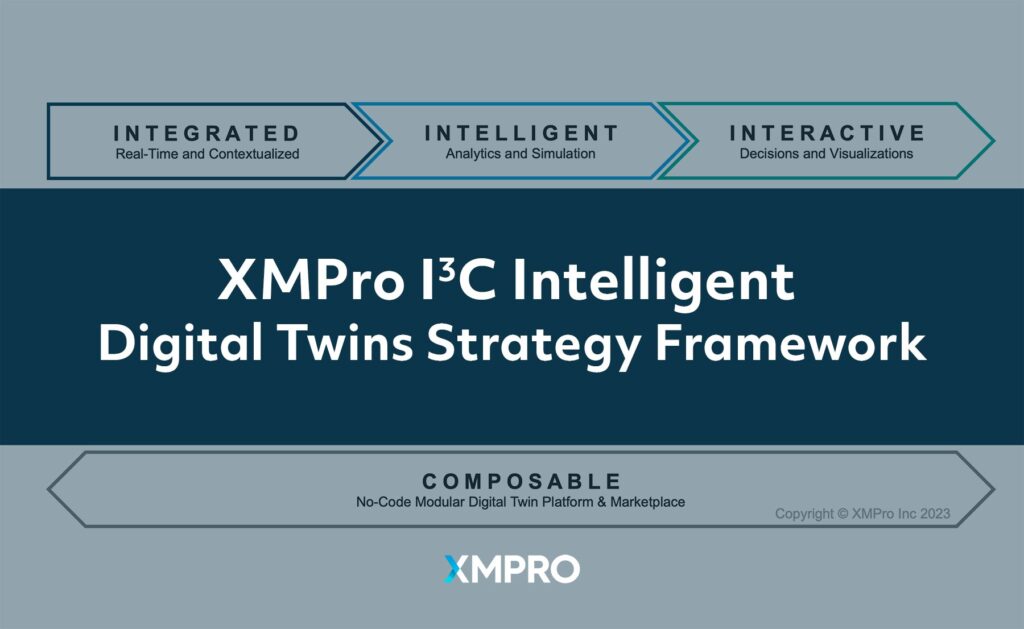
XMPro I3C Intelligent Digital Twins Strategy Framework
Introducing XMPro’s I3C Intelligent Digital Twin framework, a cutting-edge solution designed to help organizations harness the power of Intelligent Digital Twins (IDTs) in their operations. Building upon the concepts of traditional digital twins and inspired by Dr. Michael Grieves’ vision (The Roadmap to Intelligent Digital Twins), our I3C framework aims to empower organizations with a strategic roadmap for the seamless adoption and integration of IDTs. By leveraging the active, online, goal-seeking, and anticipatory nature of IDTs, businesses can unlock unprecedented levels of operational efficiency, optimize processes, and minimize resource usage.
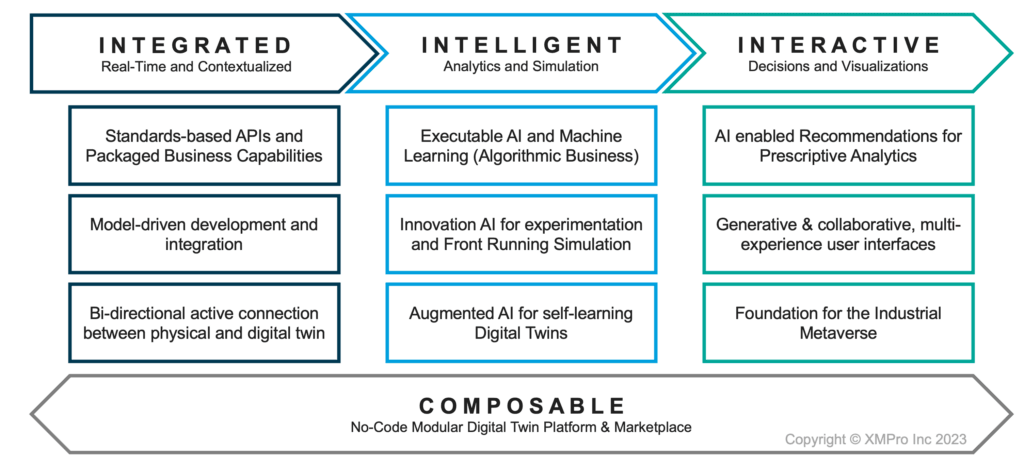
Figure 3- XMPro I3C Intelligent Digital Twin Framework: Integrated, Intelligent, Interactive, and Composable
In this blog post, we delve into the four foundational pillars of Intelligent Digital Twins that set them apart from traditional solutions: Integrated, Intelligent, Interactive, and Composable. We’ll explore how these aspects work together to create a powerful, cohesive platform, empowering organizations to harness real-time data, leverage advanced analytics, make data-driven decisions, and rapidly adapt to evolving business landscapes.
Integrated: Real-time and Contextualized
Integrated Digital Twins unite data from diverse, heterogeneous sources, creating a cohesive, common operating picture that enhances decision-making capabilities beyond traditional siloed data approaches.
An Integrated Digital Twin approach can reduce integration costs and time by 30%-50% over the lifecycle of digital twin applications. This is possible by following the three principles:
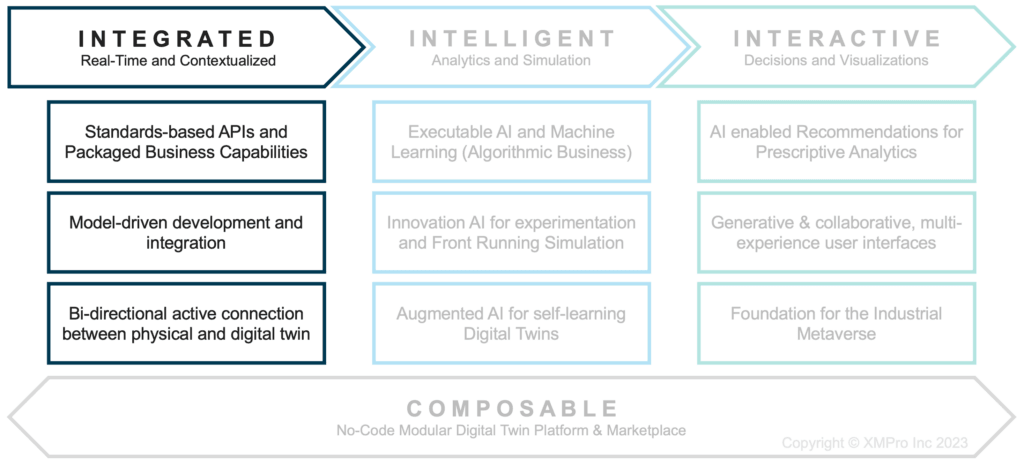
Figure 4 -XMPro I3C Intelligent Digital Twin Framework: Integrated
Standards-based APIs and Packaged Business Capabilities:
Organizations should adopt a standards-based API approach when integrating data from heterogeneous sources for digital twins, leveraging XMPro Agents in data streams for several compelling reasons:
- Interoperability: By adhering to standardized APIs, XMPro Agents can communicate and exchange data with various systems, regardless of the underlying technology or vendor. This seamless integration reduces compatibility issues and fosters collaboration between different platforms.
- Simplified Integration: Utilizing standards-based APIs, XMPro Agents streamline the process of connecting diverse data sources, providing a consistent and well-documented interface for data exchange. This approach simplifies the complexity of integrating multiple systems, saving time and resources.
- Improved Data Quality: Standardized APIs, implemented by XMPro Agents, enforce data consistency and validation rules, maintaining the quality and accuracy of the exchanged data. Accurate, real-time data is crucial for digital twins to generate insights and drive decision-making.
- Faster Deployment: XMPro Agents using standards-based APIs enable organizations to rapidly deploy digital twin solutions, as the standardized interface allows for quicker integration of new data sources or updates to existing ones. This accelerates time-to-value for digital twin implementations.
- Scalability and Adaptability: A standards-based API approach, combined with XMPro Agents, provides a flexible and modular foundation for digital twin solutions, making it easier to scale and adapt the system as the organization’s needs change. This flexibility ensures the digital twin solution remains relevant and effective over time.
- Future-proofing: Adopting standards-based APIs with XMPro Agents helps future-proof digital twin implementations, as standardized interfaces are more likely to be supported by new technologies or vendors entering the market. This reduces the risk of obsolescence and ensures a longer lifespan for the digital twin solution.
- Packaged Business Capabilities (PBCs): PBCs allow organizations to encapsulate specific functionalities or processes as modular, reusable components. XMPro Agents can easily integrate these components into the digital twin architecture to address various business needs and requirements. This approach enables organizations to rapidly deploy and scale digital twin solutions while maintaining flexibility and adaptability to changing business environments.
Model-driven development and integration:
Model-driven development and integration approaches offer several key benefits when building composable digital twins:
- Abstraction and Simplification: Model-driven development allows developers to focus on high-level business logic and functionality by abstracting away the underlying complexities of the system. This simplification enables quicker and more efficient development of digital twin components.
- Reusability and Modularity: With a model-driven approach, digital twin components are designed as reusable and modular building blocks. This allows organizations to easily compose, reconfigure, and extend their digital twin solutions to meet changing requirements or address new use cases, enhancing flexibility and adaptability.
- Consistency and Standardization: Model-driven development promotes consistency and standardization across the digital twin solution by providing a unified methodology and framework for designing components. This ensures that the various parts of the digital twin system are compatible and can work together seamlessly.
- Improved Quality and Maintainability: Model-driven development can lead to improved software quality and maintainability by enforcing best practices and reducing the potential for human error. Additionally, the use of high-level models can make it easier to understand, troubleshoot, and modify the digital twin system as needed.
- Enhanced Collaboration: A model-driven approach fosters better collaboration between various stakeholders, such as domain experts, developers, and system architects. By providing a common, visual representation of the digital twin system, model-driven development enables all parties to more effectively communicate, align their efforts, and work together towards a shared goal.
Bi-directional active connection between physical and digital twin
Bi-directional active connections between physical and digital twins offer several key benefits that enhance the overall effectiveness and value of digital twin technology:
- Real-time Data Synchronization: A bi-directional connection ensures that the digital twin continuously receives real-time data from the physical asset, enabling it to accurately reflect the asset’s current state and performance. Conversely, the physical asset can receive updates or adjustments from the digital twin, enabling more dynamic and responsive interactions between the two.
- Improved Decision-Making: With up-to-date and accurate data, digital twins can generate more reliable insights and recommendations, empowering decision-makers to make well-informed choices based on the current state of the physical asset. This leads to better outcomes and more efficient use of resources.
- Enhanced Predictive and Prescriptive Capabilities: Bi-directional connections enable digital twins to learn from the physical asset’s behavior and continuously refine their predictive models. This results in more accurate predictions and prescriptions, which can help prevent issues, optimize performance, and extend the asset’s lifespan.
- Faster Response to Changes: The active connection allows digital twins to rapidly detect and respond to changes in the physical asset’s conditions or performance. This enables organizations to address potential issues or opportunities more quickly, reducing downtime and mitigating risks.
- Closed-Loop Control: Bi-directional active connections enable closed-loop control, where the digital twin can not only monitor the physical asset but also directly influence its operation. This allows for more precise control, automation, and optimization of asset performance, further improving efficiency and reducing costs.
- Better Integration with Business Systems: The active connection between the digital twin and the physical asset facilitates seamless integration with other business systems, such as ERP or CRM, enabling organizations to leverage the insights from digital twins across their entire operation.
- Continuous Improvement: Bi-directional connections foster a continuous feedback loop between the digital and physical twins, enabling ongoing improvement and adaptation as the physical asset and its operating environment evolve over time. This helps ensure that the digital twin remains relevant, effective, and aligned with the organization’s objectives.
Intelligent: Analytics and Simulation
By consolidating data into a common operating picture, digital twins provide the ideal foundation for harnessing the power of AI and machine learning. This enables the generation of novel insights and recommendations previously unattainable with isolated point solutions. As a result, intelligent digital twins unlock new possibilities for data-driven decision-making and propel organizations toward greater efficiency and innovation.
Intelligence in Digital Twins can result in 10x effectiveness improvement in Composable Digital Twin applications. The following three mechanisms for leveraging AI and intelligence enables these business outcomes:
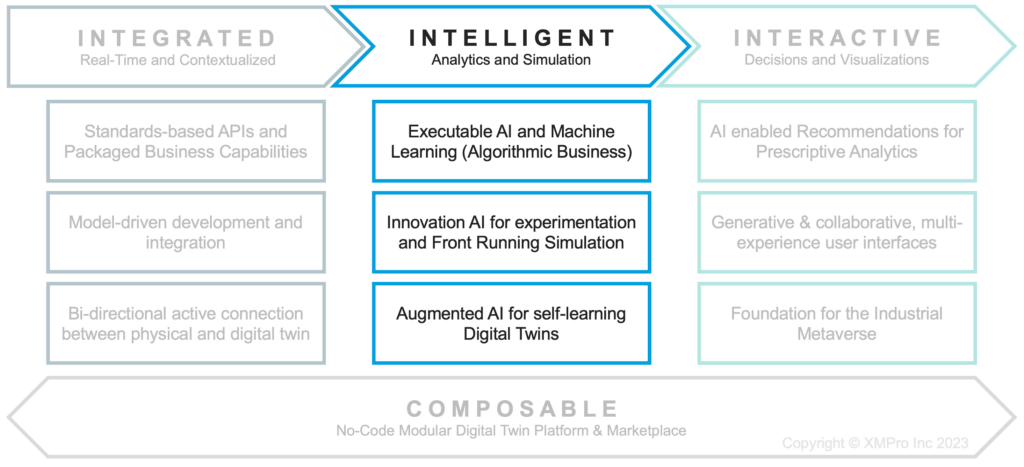
Figure 5 -XMPro I3C Intelligent Digital Twin Framework: Intelligent
Executable AI and Machine Learning for Algorithmic Business Processes
Embedding XMPro AI Agents in XMPro Data Streams enables Executable AI and Machine Learning for Algorithmic Business Processes, which in turn, enhances the capabilities of operational digital twins. This integration offers several key benefits:
- Real-time Analytics: By incorporating AI Agents into Data Streams, digital twins can process and analyze data in real-time, generating immediate insights and recommendations. This allows organizations to make informed decisions and respond to changing conditions more quickly, improving operational efficiency and agility.
- Continuous Learning: AI Agents embedded in Data Streams can continuously learn from the data they process, refining their models and algorithms over time. This ongoing improvement enables digital twins to deliver increasingly accurate predictions and recommendations, helping organizations optimize asset performance and proactively address potential issues.
- Automation of Complex Processes: Executable AI and Machine Learning enable digital twins to automate complex, data-driven business processes, streamlining operations and reducing the need for manual intervention. This automation can lead to significant cost savings, increased productivity, and better resource allocation.
- Personalized and Adaptive Solutions: AI Agents embedded in Data Streams can adapt their algorithms to the specific needs and context of each digital twin, delivering personalized and adaptive solutions that cater to the unique requirements of individual assets and processes. This customization enhances the effectiveness of digital twins and drives better outcomes.
- Integration of AI into Core Business Processes: By baking AI into operational digital twins, organizations can seamlessly integrate advanced analytics and machine learning capabilities into their core business processes. This deep integration allows for more holistic decision-making and drives greater value from AI investments.
- MLOps: Incorporating MLOps practices into the AI Agent lifecycle ensures that the development, deployment, and maintenance of machine learning models in digital twins are efficient, scalable, and reliable. This leads to faster time-to-value, improved model performance, and better alignment between AI capabilities and business objectives.
Innovation AI for Experimentation and Front Running Simulation
XMPro Intelligent Digital Twins offer a powerful platform for facilitating innovation and experimentation in AI by incorporating XMPro Notebooks based on fully embedded and integrated Jupyter Notebooks. XMPro Notebooks provide an interactive environment that allows subject matter experts (SMEs) to experiment with data, algorithms, and models in real time.
- Rapid Experimentation: XMPro Notebooks enable subject matter experts (SMEs) to quickly test ideas, algorithms, and models, promoting a faster innovation cycle and reducing time-to-market for new solutions.
- Collaboration and Knowledge Sharing: The interactive environment of XMPro Notebooks (Jupyter Hub) allows SMEs to collaborate and share insights easily, fostering cross-functional teamwork and enhancing the overall decision-making process.
- Accessible AI for Non-Technical Users: By embedding Jupyter Notebooks within the Intelligent Digital Twin platform, XMPro empowers SMEs without deep technical expertise to harness the power of AI, democratizing advanced analytics and promoting innovation across the organization.
- Optimized Processes and Decision-Making: Through Front Running Simulations, XMPro Notebooks enable SMEs to make data-driven decisions, optimizing processes, reducing operational costs, and improving overall efficiency.
- Continuous Improvement: The iterative nature of XMPro Notebooks allows SMEs to refine their digital twins and AI models constantly, ensuring that they remain relevant, accurate, and effective as business environments and requirements evolve.
Augmented AI for Self-learning Digital Twins
XMPro Augmented AI for Self-learning Digital Twins harnesses the power of artificial intelligence and machine learning to enhance the decision support and automation capabilities of Digital Twins built on the XMPro platform.
- Real-time Anomaly Detection: XMPro Augmented AI utilizes AI and Machine Learning techniques to monitor real-time and historical recommendation data, identifying unusual patterns or deviations from expected behavior. This allows organizations to detect anomalies early, enabling rapid response and mitigation of potential issues in their Digital Twins.
- Pattern Discovery: By analyzing XMPro real-time and historical recommendation data, Augmented AI can uncover hidden patterns and trends, helping organizations understand complex relationships within their Digital Twins. This deeper understanding of the underlying dynamics leads to more informed decision-making and improved decision support.
- Continuous Learning and Adaptation: XMPro Augmented AI leverages self-learning capabilities to continuously refine its models and algorithms as new data is processed. This enables Digital Twins built on the XMPro platform to adapt and evolve over time, ensuring their insights and recommendations remain relevant and effective in a changing environment.
- Enhanced Decision Automation: By incorporating AI and Machine Learning into the decision-making process, XMPro Augmented AI can automate complex decisions and optimize decision logic within Digital Twins. This not only reduces manual intervention but also drives efficiency, accuracy, and consistency in decision-making across the organization.
- Performance Optimization: XMPro Augmented AI leverages the power of AI and Machine Learning to identify opportunities for improvement in Digital Twins built on the XMPro platform. By analyzing recommendation data and identifying patterns, Augmented AI can suggest optimizations that enhance the overall performance and effectiveness of the Digital Twins, leading to better outcomes and increased operational efficiency.
Interactive: Decisions and Visualization
Digital Twins offer invaluable decision support and automation for business users, enabling them to act on the intelligence and recommendations derived from these virtual representations in a multimodal, interactive manner.
McKinsey estimates that digital twins can improve worker productivity by 10% to 15%, reduce errors and rework by 10% to 20%, and increase worker safety by 10% to 20% in the manufacturing sector. Interactive Digital Twins based on the following three principles enable those business outcomes:
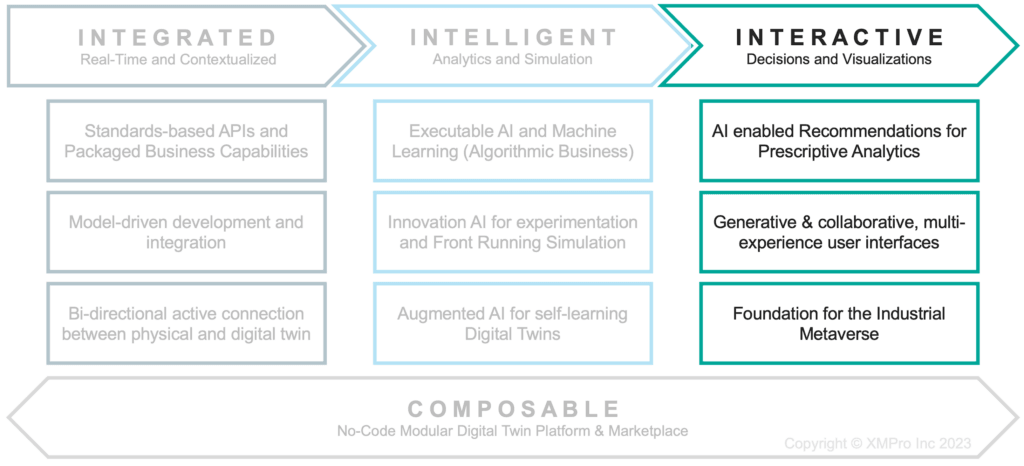
Figure 6 -XMPro I3C Intelligent Digital Twin Framework: Interactive
AI-enabled Recommendations for Prescriptive Analytics
XMPro Recommendations revolutionizes expert knowledge capture by combining rules-based methodologies with artificial intelligence, empowering digital twins to deliver prescriptive guidance with newfound precision. By leveraging AI-based recommendations, even less experienced users can receive interactive, co-pilot guidance to navigate complex decision-making processes. Here, we outline three key benefits of utilizing prescriptive analytics for recommendations in a digital twin:
- Enhanced Decision-Making: Prescriptive analytics enables digital twins to provide users with actionable insights and specific recommendations, empowering them to make informed decisions and optimize their operations.
- Adaptive Learning: As AI-based recommendations continuously learn from historical and real-time data, they become increasingly accurate and relevant, allowing digital twins to adapt and improve their prescriptive guidance over time.
- Expertise Democratization: By offering co-pilot interactive guidance, prescriptive analytics democratizes expert knowledge, allowing users of varying experience levels to effectively harness the power of digital twins and make well-informed decisions.
Generative and Collaborative Multi-experience User Interfaces
Generative and Collaborative Multi-experience User Interfaces (UI) offer a transformative approach to designing and interacting with composable digital twins. By incorporating not only traditional desktop and mobile user interfaces, but also embracing emerging technologies such as Augmented Reality (AR) and Virtual Reality (VR), these multi-experience UIs provide a seamless and immersive experience across a wide spectrum of devices and platforms. Here, we highlight three key benefits of Generative and Collaborative Multi-experience User Interfaces for composable digital twins:
- Enhanced User Engagement: By offering a diverse range of user interfaces, including AR and VR, multi-experience UIs captivate users’ attention and foster deeper engagement with digital twins, resulting in more effective decision-making and improved overall satisfaction.
- Collaboration and Knowledge Sharing: Multi-experience UIs enable users to collaborate and share knowledge across different platforms and devices, fostering a more connected and informed workforce. This collaborative environment promotes cross-functional teamwork and leads to better, more informed decision-making.
- Personalized and Context-Aware Experiences: Generative and Collaborative Multi-experience User Interfaces can adapt to users’ preferences, device capabilities, and contextual information, delivering tailored and intuitive interactions that cater to individual needs. By providing a personalized experience, multi-experience UIs ensure that users can effectively harness the full potential of composable digital twins, regardless of their preferred interface or device.
Foundation for the Industrial Metaverse
Digital twins are the foundation of the Industrial Metaverse because they serve as the bridge between the physical and digital worlds, enabling seamless integration, collaboration, and innovation across various industries. By creating virtual representations of assets, processes, and systems, digital twins allow organizations to harness the power of advanced analytics, AI, and machine learning to gain valuable insights, optimize operations, and drive decision-making. Here are several key reasons why digital twins are essential to the Industrial Metaverse:
- Data Integration and Analysis: Digital twins enable organizations to aggregate and analyze data from multiple sources, providing a comprehensive view of their assets and processes. This data-driven approach enhances decision-making capabilities and offers a more accurate understanding of the real-world systems they represent.
- Real-time Insights and Predictive Capabilities: Digital twins offer real-time monitoring and predictive analytics, allowing organizations to proactively identify potential issues, optimize performance, and improve overall efficiency. These capabilities help businesses respond more effectively to changing market conditions and minimize operational disruptions.
- Collaboration and Innovation: The Industrial Metaverse fosters collaboration among different stakeholders, including manufacturers, suppliers, and customers. This interconnected ecosystem allows organizations to share knowledge, resources, and expertise, driving innovation and enabling the development of new products, services, and business models.
- Enhanced Simulation and Experimentation: Digital twins provide a virtual environment for testing and simulating various scenarios, reducing the risks and costs associated with physical trials. This enables organizations to experiment with new ideas, strategies, and technologies, accelerating the pace of innovation and growth.
- Scalability and Flexibility: Digital twins are highly scalable and adaptable, making it easier for organizations to expand their operations, adopt new technologies, and respond to changing market demands. This flexibility ensures that businesses can maintain a competitive edge in a rapidly evolving digital landscape.
By serving as the foundation of the Industrial Metaverse, digital twins are transforming the way organizations operate, collaborate, and innovate, unlocking new opportunities for growth and success in the digital era.
Composable: No Code Modular Digital Twin Platform and Marketplace
Composability in a No Code Modular Digital Twin Platform and a supporting Marketplace are foundational elements of an intelligent digital twin framework because they enable organizations to rapidly design, develop, and deploy digital twin solutions tailored to their unique needs and requirements.
Analysts predicts that by 2023, organizations that have adopted an intelligent composable approach will outpace the competition by 80% in the speed of new feature implementation. Composable Digital Twins is a typical implementation of composable business approach.
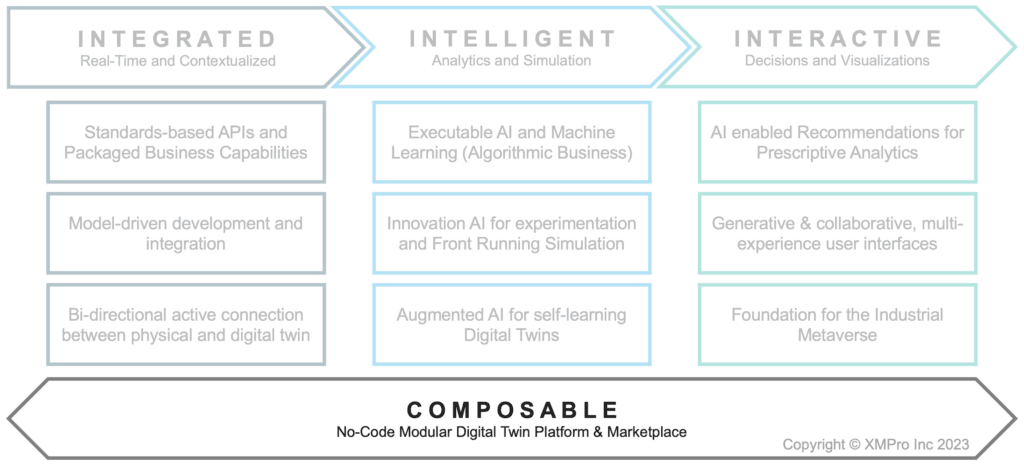
Figure 7 – XMPro I3C Intelligent Digital Twin Framework: Composable
By leveraging modular components and pre-built templates, businesses can streamline the development process, foster collaboration, drive innovation across their operations, and enhance security. Here are six supporting reasons to use a Composable Digital Twin platform like XMPro:
- Rapid Deployment: Composability in a No Code platform such as XMPro allows organizations to quickly assemble and deploy digital twin solutions by combining pre-built modules, templates, and components, significantly reducing development time and accelerating time-to-value.
- Flexibility and Adaptability: A modular platform enables businesses to easily modify, expand, or reconfigure their digital twin solutions in response to evolving needs or emerging opportunities, ensuring that their digital twin framework remains relevant and effective over time.
- Collaborative Development: No Code platforms and supporting Marketplaces foster collaboration among various stakeholders, including domain experts, developers, and system architects, facilitating better communication and alignment of efforts towards a shared goal.
- Reusability and Standardization: Modular digital twin platforms like XMPro, promote reusability and standardization, as organizations can leverage pre-built components and templates across multiple digital twin solutions, ensuring consistency, compatibility, and seamless integration.
- Security: Composability in a No Code platform ensures that security best practices are consistently applied across all digital twin components, safeguarding sensitive data and protecting against potential threats, while promoting trust and confidence in the digital twin ecosystem.
- Cost and Resource Efficiency: Composability in a No Code Modular Digital Twin Platform like XMPro, reduces the need for extensive custom development, lowering overall development costs and allowing organizations to allocate their resources more effectively.
Composability in a No Code Modular Digital Twin Platform and a supporting Marketplace provide the foundation for an intelligent digital twin framework by enabling rapid deployment, flexibility, collaboration, reusability, enhanced security, and cost efficiency, empowering organizations to unlock the full potential of digital twin technology.
XMPro’s I3C Intelligent Digital Twin framework offers a comprehensive, cutting-edge solution that enables organizations to embrace the future of industry and digital transformation. By integrating real-time data and insights, harnessing AI and machine learning capabilities, revolutionizing decision-making and collaboration through interactive digital twins, and leveraging the power of composability with no-code modular platforms and marketplaces, organizations can unlock the full potential of digital twin technology. The I3C framework not only ensures seamless adoption and integration of Intelligent Digital Twins but also empowers businesses to optimize their operations, enhance decision-making, and drive innovation. By adopting the XMPro I3C framework, organizations can confidently navigate the ever-evolving digital landscape and thrive in the era of Intelligent Digital Twins. Don’t miss the opportunity to revolutionize your operations, accelerate growth, and gain a competitive edge. Contact us today to discuss how the framework can be applied to your Digital Twin journey. {See blog post 3 for XMPro AI announcement}











